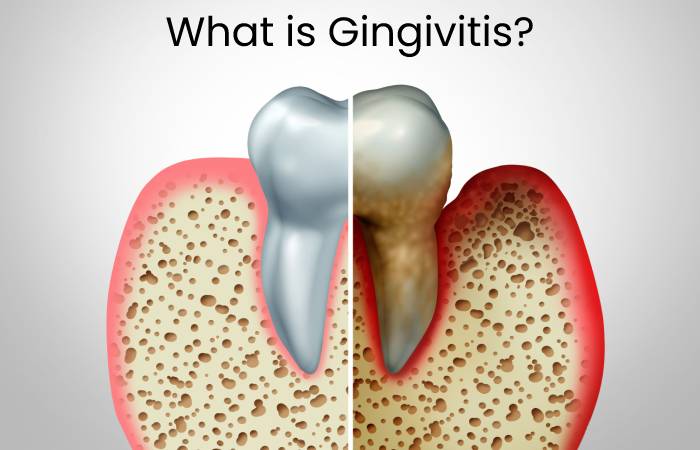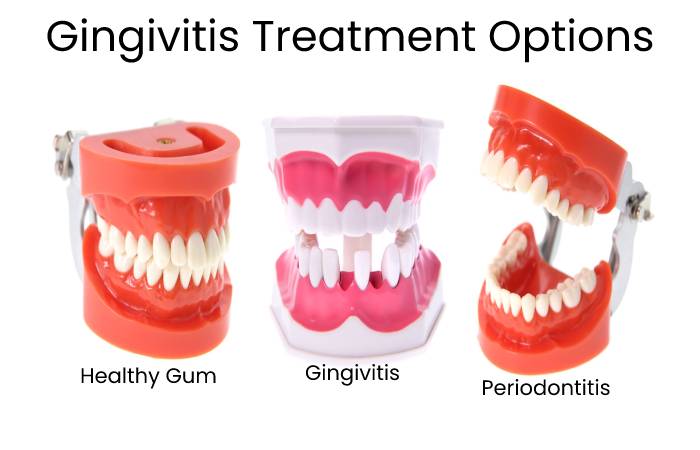Gingivitis Treatments and Medications – Healthy gums and connective tissues keep the teeth healthy and in place. Swelling or bleeding of the gums can be a symptom of gingival inflammation. If you encounter any of these problems, contact your dentist before the symptoms develop into a more gingival severe disorder. See below for the signs of tendinitis and how to treat them.
Table of Contents
What is Gingivitis?
Dermatitis is swelling, redness, inflammation, and bleeding of the gums. These gums, called gums, are soft tissues that attach to and cover the neck of the tooth (and the crown of the unruptured tooth). With a deeper bond, the gum helps keep the teeth in place. Although the symptoms may be mild, gingival inflammation is the first stage of gingival disease (rare disease). Gingival inflammation can become more severe if left untreated, leading to tooth loss.
There are many causes of gingival inflammation, but the most common cause is plaque accumulation due to poor oral hygiene. Dermatitis can also cause by certain drugs such as infections, allergic reactions, malnutrition, pregnancy, birth control drugs, calcium channel blockers, blood pressure drugs, and the antiepileptic drug phenytoin.

Most Gingival Inflammation is the Result of Plaque Accumulation.
However, most gingival inflammation is the result of plaque accumulation. Dental plaques are thin films formed from food particles, saliva, and bacteria on the surface of teeth. Regular brushing, flossing, and dental cleaning remove plaques and bacteria from your teeth. However, poor dental hygiene causes plaques to build up, harden and become tartar, sneaking under the gums. When the immune system attacks bacterial colonies under the gums, this causes swelling, redness, and inflammation of the gums, which is characteristic of gingival inflammation.
If left untreated, plaques build up, pulling the gums away from the teeth and creating spaces or “pockets” between the teeth and gum tissue. As these pockets expand and the infection penetrates deeper tissues, gingivitis develops into periodontitis. It is a severe condition that can ultimately lead to the loss of teeth and bones.
Dermatitis is one of the most common dental conditions in the world. Almost 50% of adults over 30 have periodontal disease, depending on age, genetics, and lifestyle. Dermatitis is less common among young children and people with good dental hygiene. It is more common among adolescents and the elderly. Neglect and poor oral health are the main risk factors for gingival disease, while other risk factors include genetics, smoking, diabetes, pregnancy, tooth congestion, and thirst.
How is gingivitis diagnosed?
Dermatitis is mainly diagnosed by visual inspection of the gums. Dermatitis is primarily diagnosed and treated by dentists and dental hygienists, but in more severe cases, it may be referred to a periodontologist specializing in gingival diseases.
Many patients are mild or asymptomatic and may not be aware of their gums’ problems. Even if the symptoms are mild, you should consult a dental professional if you notice any of the following signs of gingival inflammation:
- Gum bleeding when brushing, flossing, or eating
- Bad breath that does not recover with brushing
- Gum swelling or receding
- Red gum
- Soft or sensitive gum
Dental specialists diagnose gingival inflammation based on the appearance of the gums and X-ray results. Early gingivitis affects only the gingival tissue between the teeth (interdental papilla). While more severe gingivitis affects most of the gums that cover the crown.
No clinical examination is required unless the dental professional suspects a more serious condition such as periodontitis.
Gingivitis Treatment Options
Treatment of gingivitis focuses on reducing inflammation, removing plaques, and adopting appropriate oral care habits to prevent plaque buildup. In addition, antiseptics and antibiotics may be needed to control the growth of bacteria under the teeth and stem.

Lifestyle Changes
Initial treatment may include discontinuing or changing if a drug or malnutrition causes gingivitis. So, for example, the drug causing gingivitis, changing the diet or prescribing supplements. Ask your doctor for medication advice – do not stop or change your medication yourself.
Oral Hygiene
Improving oral hygiene is essential in managing the condition of all types of gingivitis. The teeth should brush and floss regularly. The American Dental Association recommends brushing your teeth twice daily and flossing once daily.
Scaling And Root Planning (SRP)
In most cases, gingival inflammation is caused by plaque buildup, so the first treatment is scaling and root planing, or deep cleaning. Scaling removes plaque below the gingival line, and root flattening smoothes the root’s surface and allows stalk tissue to reattach the tooth.
Medications – Gingivitis Treatments
After a thorough rubbing, the dentist may prescribe a disinfectant mouthwash, topical antibiotics, or disinfectants. In addition, the dentist may prescribe a short course of oral antibiotics for more severe infections or periodontitis.
Gingivitis Medications – Gingivitis Treatments
Prevention and treatment of gingival inflammation are based on oral hygiene with twice-daily toothbrushing, mouthwash, and flossing to prevent or reduce the formation of plaques and bacteria. Severe cases can treat with short-term antibiotics.
Toothpaste And Mouth Rinses
The mainstay of dermatitis treatment is over-the-counter or prescription brushing or rinsing containing antibacterial or anti-plaque agents. The primary role of brushing teeth is to mechanically remove food particles, plaques, and bacteria from the surface of the teeth. In addition, certain mouthwashes contain effective ingredients in killing bacteria and preventing plaque buildup. For mouthwash to work effectively against bacteria, do not eat, drink or brush your teeth within 30 minutes.
Toothpaste and Mouthwash Contain One or more Ingredients that Fight Plaques and Bacteria.
- Essential oil. Some essential oils, such as methyl salicylate (wintergreen), menthol, eucalyptus, and timol, are somewhat effective in fighting bacteria and relieving inflammation of the gums. One or more of these ingredients are often found in over-the-counter Listerine Essential Care or Listerine. They may effectively prevent or treat early-stage gingivitis in patients with good dental health and daily oral hygiene. Hygiene habits.
- Tin fluoride. In addition to toothpaste (Parodontax, Crest Pro-Health, and Crest Gum Detoxify) and mouthwash (3M ESPE period), it helps prevent cavities. Stannous fluoride tin (tin) is a powerful antibacterial agent that prevents or significantly reduces gingival inflammation. Prescription toothpaste and mouthwash provide higher concentrations of stannous fluoride than over-the-counter formulations.
- Surgeons use chlorhexidine, a powerful antibacterial agent, to disinfect the skin before surgery. Chlorhexidine mouthwash (Colgate Periogard, 3M Peridex, and GUM Paroex) is the most effective mouthwash for killing bacteria. Brushing removes chlorhexidine from the teeth, so brushing should avoid for at least 30 minutes after rinsing.
- Cetylpyridinium chloride. Cetylpyridinium chloride (CPC) in Colgate TotalCare and Crest Pro-Health Mouthwash effectively kills plaque-forming bacteria. However, it is believed to be less effective than chlorhexidine.
- Hydrogen peroxide. Another powerful disinfectant, hydrogen peroxide, treats mouth pain in toothpaste (Arm & Hammer PeroxiCare) as a tooth whitener and mouthwash (Colgate Peroxyl and Orajel). In addition, hydrogen helps prevent or treat gingival inflammation. Therefore, some dentists recommend hydrogen peroxide products for daily gum care.
- Classified as a medical expedient rather than a drug, Delmopinol Mouth Wash (GUM PerioShield) suppresses plaque formation and prevents bacteria from adhering to and aggregating on the plaque’s surface.
Topical Antibiotics – Gingivitis Treatments
After climbing and root planing, the dentist can apply topical antibiotics (gels, chips, strips, or microcapsules) under the teeth, gums, or gums. These topical medications include minocycline, doxycycline, tetracycline, or metronidazole. Then, slowly release antibiotics into the tissues of the teeth and gums, controlling bacterial growth and reducing pocket depth.
Oral Antibiotics – Gingivitis Treatments
Dentists may prescribe oral antibiotics for severe periodontitis but rarely for gingival inflammation. It is because, unlike topical antibiotics, oral (systemic) antibiotics have potentially dangerous side effects and are at risk of developing drug-resistant bacteria. The only exception is acute necrotizing ulcerative gingivitis (ANUG). This severe form of gingivitis requires one or more oral antibiotic regimens.
